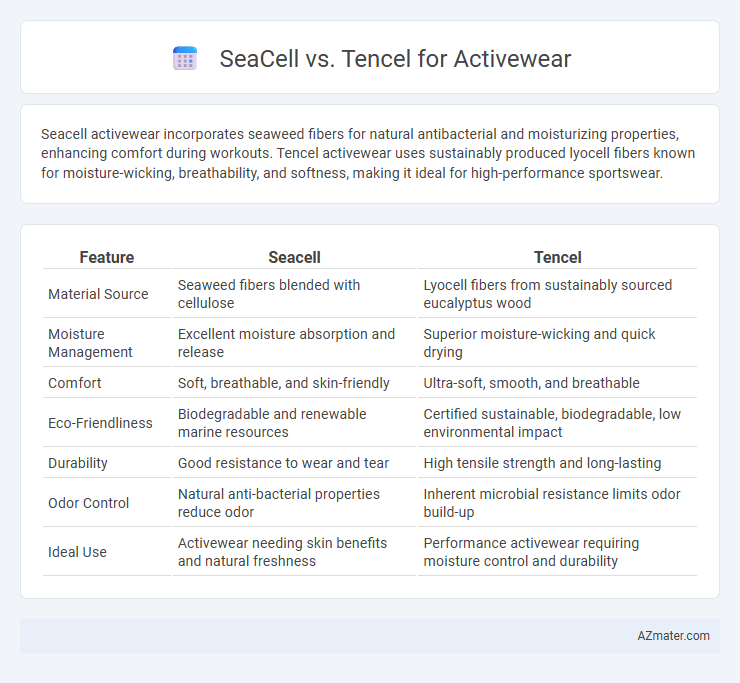Seacell activewear incorporates seaweed fibers for natural antibacterial and moisturizing properties, enhancing comfort during workouts. Tencel activewear uses sustainably produced lyocell fibers known for moisture-wicking, breathability, and softness, making it ideal for high-performance sportswear.
Table of Comparison
| Feature | Seacell | Tencel |
|---|---|---|
| Material Source | Seaweed fibers blended with cellulose | Lyocell fibers from sustainably sourced eucalyptus wood |
| Moisture Management | Excellent moisture absorption and release | Superior moisture-wicking and quick drying |
| Comfort | Soft, breathable, and skin-friendly | Ultra-soft, smooth, and breathable |
| Eco-Friendliness | Biodegradable and renewable marine resources | Certified sustainable, biodegradable, low environmental impact |
| Durability | Good resistance to wear and tear | High tensile strength and long-lasting |
| Odor Control | Natural anti-bacterial properties reduce odor | Inherent microbial resistance limits odor build-up |
| Ideal Use | Activewear needing skin benefits and natural freshness | Performance activewear requiring moisture control and durability |
Introduction to Seacell and Tencel
Seacell and Tencel are innovative fabrics gaining popularity in activewear for their sustainability and comfort. Seacell, derived from seaweed and organic fibers, offers natural skin-soothing properties and biodegradability. Tencel, made from sustainably sourced eucalyptus wood pulp, provides exceptional moisture-wicking, breathability, and strength, ideal for high-performance athletic wear.
Origin and Production Processes
Seacell is derived from seaweed fibers blended with cellulose from wood pulp, utilizing a unique extraction process that preserves the natural minerals and vitamins from the sea algae. Tencel, produced by the Austrian company Lenzing AG, is generated from sustainably sourced eucalyptus wood through a closed-loop solvent spinning method that recycles water and solvents, minimizing environmental impact. Both fibers emphasize sustainability, but Seacell's production integrates marine biomass, while Tencel focuses on wood-based raw materials with advanced eco-friendly fiber manufacturing.
Fiber Composition and Sustainability
Seacell fibers combine cellulose from wood pulp with embedded seaweed extracts, offering skin-soothing properties and biodegradability, while Tencel fibers are made from sustainably sourced eucalyptus wood pulp through a closed-loop process that recycles water and solvents, minimizing environmental impact. Both fibers provide moisture-wicking and breathability ideal for activewear, but Tencel excels in sustainability due to its lower water usage and regenerative raw material sourcing. Seacell's unique seaweed infusion adds natural antibacterial benefits, whereas Tencel emphasizes eco-friendly manufacturing and fiber strength for durability in active garments.
Breathability and Moisture Management
Seacell fibers, infused with seaweed, offer enhanced moisture-wicking properties and natural breathability, making them ideal for activewear that requires odor control and skin nourishment during intense workouts. Tencel, derived from sustainably sourced eucalyptus wood, excels in moisture management by absorbing moisture efficiently and drying quickly, ensuring comfort and temperature regulation. Both fabrics provide superior breathability, but Tencel's smooth surface structure enhances airflow, making it highly effective for high-performance activewear.
Softness and Comfort for Activewear
Seacell fibers, derived from seaweed and cellulose, offer exceptional softness and natural moisture-wicking properties that enhance comfort during intense workouts. Tencel, made from sustainably sourced eucalyptus wood pulp, provides superior breathability and a smooth, silky texture that reduces friction and skin irritation. Both fibers excel in softness and comfort, but Seacell's natural bioactive properties add an anti-bacterial advantage ideal for activewear.
Antibacterial and Skin-Friendly Properties
Seacell fibers, enriched with seaweed extracts, offer natural antibacterial properties and enhance skin hydration, making them highly suitable for activewear aimed at sensitive skin. Tencel, produced from sustainably sourced eucalyptus fibers, exhibits excellent moisture-wicking and breathability while maintaining hypoallergenic characteristics that reduce skin irritation. Both fibers contribute to activewear that supports skin health, but Seacell's unique seaweed compounds provide an additional antimicrobial benefit that can help control odor during intense physical activity.
Durability and Care Requirements
Seacell activewear offers moderate durability due to its cellulose fibers infused with seaweed, which provides natural antioxidant properties but may require gentle washing to maintain fabric integrity. In contrast, Tencel, made from sustainably sourced eucalyptus wood pulp, exhibits higher durability and resistance to pilling, supporting frequent use and machine washing without significant wear. Care requirements for Seacell typically involve hand washing or delicate cycles, while Tencel activewear is more versatile, tolerated by standard washing machines with less risk of damage.
Environmental Impact Comparison
Seacell fibers are derived from seaweed combined with cellulose, resulting in a biodegradable and renewable material that supports ocean health through algae regeneration. Tencel, produced by Lenzing using sustainably sourced wood pulp and a closed-loop process, minimizes water and chemical usage while achieving near-zero waste. Both innovations offer eco-friendly alternatives to conventional fabrics, with Seacell emphasizing marine ecosystem benefits and Tencel excelling in resource-efficient production for sustainable activewear.
Performance in Activewear Applications
Seacell and Tencel fibers both offer unique performance benefits for activewear, with Seacell providing superior moisture-wicking and natural antibacterial properties due to its seaweed infusion, which enhances odor control during intense workouts. Tencel excels in breathability and softness, maintaining structural integrity and rapid moisture absorption, making it ideal for high-sweat activities. Both fibers deliver durability and eco-friendly attributes, but Seacell's additional skin-nourishing benefits make it particularly advantageous for performance-driven activewear.
Conclusion: Which Fiber is Better for Activewear?
Seacell and Tencel both offer sustainable, moisture-wicking properties ideal for activewear, but Tencel excels due to its superior breathability and durability under intense physical activity. Seacell provides unique skin benefits and anti-odor qualities, making it suitable for sensitive skin and casual athletic wear, yet Tencel's higher tensile strength and moisture management make it the preferred fiber for high-performance sports clothing. Brands prioritizing long-lasting, eco-friendly activewear often choose Tencel for its balance of comfort, sustainability, and functionality.

Infographic: Seacell vs Tencel for Activewear
 azmater.com
azmater.com